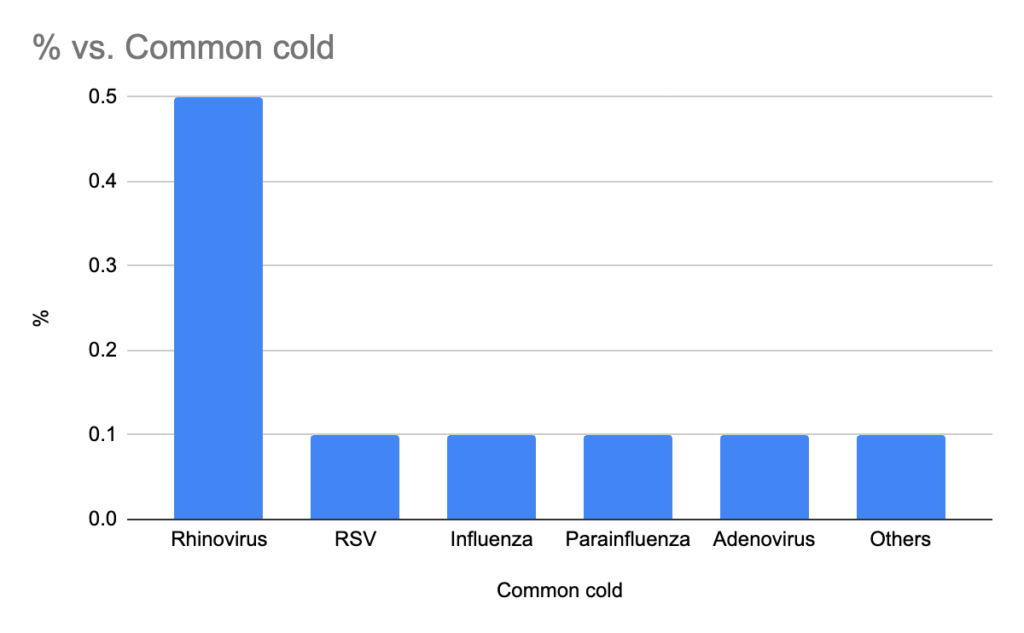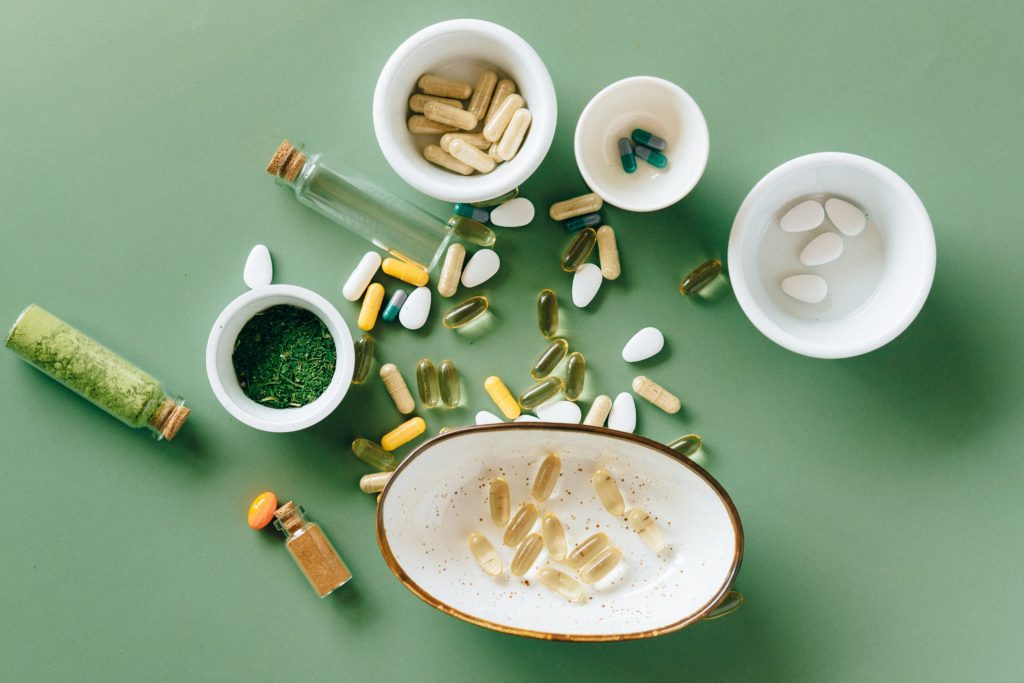
–by Dr. Peng E. Wang
Introduction
The common cold is a phrase to describe upper respiratory symptoms involving the sinuses, nose, throat, and the voice box (Wiki). The terminology is not specific to one organism since many pathogens can cause the common cold. Although it may be interesting to discover what causes the common cold, it is a futile exercise as the management starts the same. This article discusses the common cold symptoms and the best cold treatments with self-care tips.

Overview
The common cold occurs in nearly every person, and most of us get one or two colds yearly. In general, people do not call the doctor for a common cold unless the symptoms persist, or if there are complications.
The cold symptoms typically are sneezing, runny nose, congestion, sinus pressure, sore throat, and cough (NCBI). Fever is not a common occurrence with the common cold, therefore it’s not always easy to tell if it’s just a cold or allergies-induced cold-like symptom due to mold, dust mites, or other pathogens.
However, when you think about it, the initial management of the common cold, regardless of the pathogen, should be the same. More importantly, what not to do when you have cold-like symptoms because it can worsen your symptoms and cause complications.
The Common Cold Symptoms
Typically symptoms onset of a common cold occur after 10-12 hours of contact, and the symptoms can last between 7-21 days (NCBI).
Common
- Sneezing
- Runny nose
- Congestion
- Sinus pressure
- Headache
- Fatigue and general unwell feeling
- Sore throat (due to drainage)
- Cough (due to drainage)
- Feverish feeling with temp <100°Fahrenheit (37.8°Celsius)
Less common
- Fever above 100.4 °Fahrenheit (38 °Celsius)
- Body aches
- Chills
Rare symptoms (Seek urgent care)
- Chest pain
- Shortness of breath with exertion (dyspnea)
- Severe ear pain with fever >100°Fahrenheit (needs otoscopy, ear scope)
Early recognition of common cold symptoms can help you decide when to isolate. Additionally, it provides an estimate of the quarantine period and monitoring of the symptom progression. More importantly, the rare symptoms call for immediate evaluation because “walk-in” pneumonia and middle ear infections are possible from a simple cold. Pneumonia means there is a fluid collection in your lower airway, and bronchitis means you have a fluid collection in your mid-airway; these phrases do not equal bacterial infection.
The Common Cold Treatments
Recommended
Self-care tips
- Humidify the air in your bedroom
- Drink fluids with electrolytes (Gatorade, Smart Water, etc.)
- Dress in layers of clothing so you can adjust as needed
- Supplements including Zinc and multivitamins can increase the co-factors your body needs to fight the infection since they will be utilized more
- Natural remedies such as honey, Echinacea, Elderberry, and Eucalyptus reduce the toxicity/irritability of the mucus thus helping with painful throat and reducing inflammation in turn
Antihistamines type 1; over-the-counter; best to be scheduled
- Claritin, the active ingredient is loratadine, with fast onset in one hour if taken on an empty stomach
- Clarinex, the active ingredient is desloratadine, an analog of Claritin, has fewer side effects
- Zyrtec, active ingredient is cetirizine, with fast onset in one hour if taken on an empty stomach
- Xyzal, the active ingredient is levocetirizine, an analog of Zyrtec, with fewer side effects
Fever and pain reducer; over-the-counter
- Tylenol, active ingredient is acetaminophen, 500mg or 325mg, use as needed
Nasal steroid topicals; over-the-counter; as needed
- Flonase, the active ingredient is fluticasone propionate, slow onset, alcohol-based solution
- Nasacort, the active ingredient is mometasone, slow onset, non-alcohol based solution (less likely to cause nosebleed)
Cough suppressants; over-the-counter; as needed
- Delsym, the active ingredient is Dextromethorphan, also in cold medicines such as Nyquil
Cough suppressants; Prescription; as needed
- Tessalon Perles, the active ingredient is Benzonatate, prescribed for common colds, and persistent cough
- Codeine is a common narcotic that functions through the mu receptor pathway (controlled prescription)
Non-steroid Anti-inflammatory Drugs (NSAID); best to be scheduled
Reactive cough > 10 days use Inhaled corticosteroids; prescription only; best to be scheduled
- Fluticasone, known as Flovent, the powder form was discontinued; aerosol (HFA) available
- Mometasone, known as Asthmanex; aerosol (HFA) and Twisthaler (powder)
- Budesonide, known as Pulmicort; aerosol (HFA) or nebulized only
- Advair Diskus, fluticasone/salmeterol; with a long-acting form of albuterol, twice daily
- AirDuo Respiclick, fluticasone/salmeterol; same as Advair but has a generic, less expensive, twice-daily
- Breo Ellipta, fluticasone/vilanterol; only once daily, expensive
- Symbicort HFA, budesonide/formoterol, aerosol only
- Wixela, fluticasone/salmeterol; same as Advair, but has generic, less expensive, twice daily
Do Not recommend
Over-the-counter cold remedies (Ironically)
- Dayquil, active ingredients include phenylephrine and guaifenesin
- Mucinex Cold/Flu, active ingredients include phenylephrine, a decongestant
- Any packaging that states “Cold and Sinus” and “Cold and Flu”
Mucus relief (expectorants)
- Mucinex, the active ingredient is guaifenesin, also in Robitussin and many cold medicines
- Mucinex Children’s Stuffy Nose
- Mucinex Sinus-Max Clear & Cool
Decongestants (Hides well in many remedies, look at the ingredients)
- Afrin nasal spray, the active ingredient is oxymetazoline
- QlearQuil 12-Hour Nasal Decongestant Moisturizing Spray
- Vicks Sinex 12-Hour
- Vicks Sinex Severe Decongest
- Mucinex Children’s Stuffy Nose
- Mucinex Sinus-Max Clear & Cool
- Dayquil, active ingredients include phenylephrine
Behind the counter
- Claritin-D, active ingredients are loratadine and pseudoephedrine
- Zyrtec-D, active ingredients are cetirizine and pseudoephedrine
- Allegra-D, active ingredients are fexofenadine and pseudoephedrine
- Mucinex-D, active ingredients are guaifenesin and pseudoephedrine
Antibiotics
- Z-pack, active ingredient is azithromycin
Related article: 7 Common Medications for Cough
Complications and Prevention
When you have a cold, the initial response of your body’s immune response is hyperactivity with mucus production, and dilation of the arteries inside your airway. This occurs in the local region involving your sinuses, nasal cavity, and glands (tonsils), thus removing tonsils early isn’t a great idea since it’s a part of your immune system (Wiki).
Physical defense system against pathogens (NCBI)
- Nasal hairs block pathogens from entering
- Mucus trapping pathogens (mucus has its purpose)
- The angle between the pharynx (throat) and your nasal cavity prevents falling of pathogens into the airway
- Tonsils are your first immune response to a pathogen
- Ciliated hairs move mucus upward only keeping pathogens away from the lungs
Your body is trying to quarantine pathogens with mucus and inflammation while preventing mucus from accumulating in the lower airways (lungs), so you get the cold symptoms. It is important to know what not to do to increase the challenge. Ultimately, for a respiratory infection, the challenge is impaired oxygen delivery due to fluid accumulation. Cold remedies with decongestants and expectorants risk fluid buildup in your airway and the following complications.
Complications
- Middle ear infection; ear pains and fever >102F
- Serous otitis media; fluid behind the eardrum and hearing loss
- Bronchitis; fluid in the mid-airway causing wheezing, shortness of breath, and fever
- Pneumonia; fluid in the lower airway causing fever, fatigue, shortness of breath, and very ill feeling
When to see a doctor
- Fever recurring after the initial fever has resolved
- Ear pain with a fever
- Sinus impaction (not draining) with a fever
- Shortness of breath with exertion (dyspnea)
- Overall very unwell feeling
Prevention
- Avoidance of contact with ill individuals
- PPE (personal protective equipment) including masks and glasses
- Hand washing after contact
- Disinfect fomites (physical objects that were in contact with ill persons)
- Adequate sleep, exercise, and hydration
- Vitamin D3 to boost vitamin D levels (NIH)
Conclusion
Although the common cold is unavoidable, there are many things you should be doing and also not doing to optimize the symptoms control. A sound management plan for the cold should reduce excessive drainage and exaggerated inflammatory response while avoiding complications. Many medications do exactly the opposite, namely Mucinex and Dayquil. Your body’s defense system tries to quarantine and destroy the pathogens during a cold, but it also tries to learn and be prepared for the next time. The frequent use of antibiotics reduces the good microbes and thus carries side effects of yeast infection and diarrhea. However, the larger concern is whether antibiotics also impair your body’s learning curve (immune response) during a cold and you will be more prone to colds. With many treatment options available for the common cold, it’s best to prevent and minimize complications, so get adequate sleep, exercise, eat a healthy diet, and boost your vitamin D level since most of us are deficient.
Bonus: Decongestants, why you should avoid it
Can decongestants make you more congested? Yes. The mechanism is more open airway by compressing the arteries lining the airway, thus allowing more space for drainage and more stomach upsets. Decongestants also cause rebound congestion, with elevated heart rate and blood pressure to a dangerous level. The difference between a vein and an artery is the amount of smooth muscle they are made of. Arteries have three layers of smooth muscle, and veins only have one. Veins are more elastic and compliant. Arteries are not very compressible. If you forcibly squeeze arteries by using decongestants, rebound congestion ensues. Bottles of nasal decongestants, such as Afrin (oxymetazoline), and others like phenylephrine in cold remedies, it’s best to avoid it.

Related article: 7 Common Medications for Cough